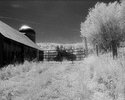I’ve seen a bit written about this but wanted to ask for clarity.
It’s known that iodine can be used for spot bleaching. That’s let a few to ask if it can be used for reversal processing and there are a few threads on this. This thread refers to a person who bleached an already exposed and fixed print and then redeveloped and got some level of redevelopment. This leads me to ask, if the print hadn’t been fixed yet, and had been exposed to light for a second exposure and then redeveloped, would a positive image result?
From what I’ve read, using iodine in solution (drug store iodine and colorless) bleaches a print to white. Water can be added to make it less aggressive. My understanding is that the developed silver is bleached and then neutralized so that it cannot be exposed / developed further but the remaining silver bromide in the paper remains unchanged. Apparently the same can be achieved with a solution of iodine potassium bromide but not potassium iodide (converts all silver including bromide rendering the print not able to be re-exposed). Much of this is explained in this thread which references an old German iodine-based reversal process based on what I’ve just described.
After reading all of this and then some other threads, I’m a bit confused. The old method described in German supposedly worked but in some responses in other threads, people have said that there can be issues with re-exposure. I’m just wondering if anyone has actually tried this in practice (based on the formulations described here — not alternatives — and also not just theorizing) and can clarify if bleaching in store bought iodine and then re-exposing will indeed create a positive image or is there something else going on that will cause some kind of fogging or other problem? Thanks for the help.
It’s known that iodine can be used for spot bleaching. That’s let a few to ask if it can be used for reversal processing and there are a few threads on this. This thread refers to a person who bleached an already exposed and fixed print and then redeveloped and got some level of redevelopment. This leads me to ask, if the print hadn’t been fixed yet, and had been exposed to light for a second exposure and then redeveloped, would a positive image result?
From what I’ve read, using iodine in solution (drug store iodine and colorless) bleaches a print to white. Water can be added to make it less aggressive. My understanding is that the developed silver is bleached and then neutralized so that it cannot be exposed / developed further but the remaining silver bromide in the paper remains unchanged. Apparently the same can be achieved with a solution of iodine potassium bromide but not potassium iodide (converts all silver including bromide rendering the print not able to be re-exposed). Much of this is explained in this thread which references an old German iodine-based reversal process based on what I’ve just described.
After reading all of this and then some other threads, I’m a bit confused. The old method described in German supposedly worked but in some responses in other threads, people have said that there can be issues with re-exposure. I’m just wondering if anyone has actually tried this in practice (based on the formulations described here — not alternatives — and also not just theorizing) and can clarify if bleaching in store bought iodine and then re-exposing will indeed create a positive image or is there something else going on that will cause some kind of fogging or other problem? Thanks for the help.





